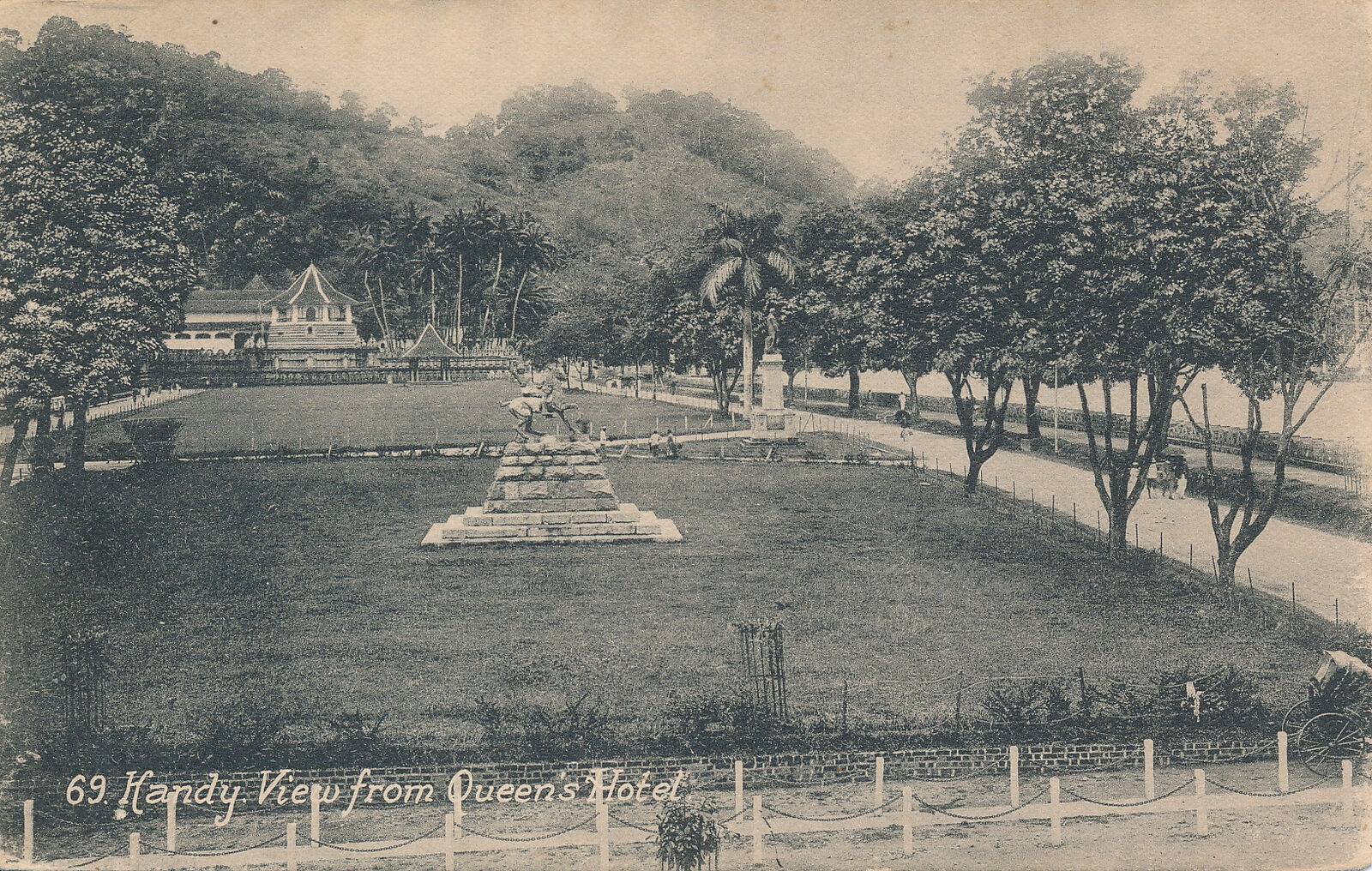The General Landscape in Ceylon
දහවල් කාලයේදී ගිනිගහන දැඩි හිරු රශ්මියක් පතිත වෙන අධික බෑවුම් පැත්තෙන් ඉහළට නගිනා කෙනෙකුට, ඇතාගල පර්වත මස්තකයේදි බටහිර දෙසෙහි වූ පහත් තැනිතලාවත්, නැගෙනහිරින් රට මධ්යයට ක්රමයෙන් උස් වෙන කඳු වළල්ලත් එක්ක කදිම දර්ශනයක් දැක බලාගන්න පුළුවන්. මේ භූදර්ශනය දැක්මෙන් සිතට නැගෙන හැඟීම නම්, ලංකාවේ ඕනෑම තැනකදි පවා හැඟෙන, ලංකාව පුරාම එක සේ පවත්නා හරිත පැහැයයක් ඇති බවට කාරණාවයි.
ලක්දිව භූදර්ශන
මෙහි ග්රීෂ්ම සෘතුව හා ශීත සෘතුව කියා වෙනසක් වෙන්නේ නෑ. (අවුරුද්දේ ඉතාම ශීත කාලය මෙය වුණත්, සාමාන්ය උෂ්ණත්වය 850 ක් 900ක් අතර වෙනවා) මෙහෙ ගස් කොළන් වල කොළ හැලී යන්න නිශ්චිත කාලයක් නෑ. ඒත් තනි ගස්, අතරින් පතර විරාමයක් අරගෙන විඩා නිවාගන්නවා.
 |
| Ceylon Railway Engine 66 at Kurunegala in 1909, the elephant rock is in the background [Image Courtesy: http://www.lankapura.com ] |
බැලු බැලූ හැම පැත්තකම ඇස ගැටෙන්නේ එකම පැහැයක්. ලඳු කැලෑ යායක හරිත පැහැය, නැතිනම් ඝන කැලෑවක හරිත පැහැය, ඒත් නැතිනම් වෙල් යායක හරිත පැහැය. මේවා ඇරුණත් ඉතිරි ටිකත් ඔක්කොම වගේ තියෙන්නේ කෙසෙල් ගස් වලයි, පොල් ගස් වලයි හරිත වර්ණය. පොදුවේ ගත්තම මේක ටිකක් ඒකාකාර වුණාට, ඒ ගතිය සෑහෙන්න මඟ හැරෙනවා වර්ණවත් පුෂ්පයන්ගෙනුයි, විවිධාකාර කෘමී සත්තුන්ගෙනුයි ලබා ගන්න පුළුවන් සමීප දර්ශන වලින්.
 |
| Kurunegala (Raja Pihilla) Rest House, Ceylon |
එක් කුහුල් දනවන කාරණාවක් වෙන්නේ මේ රටේ හොඳ ජනගහණයක් දකින්න තිබුණත්, මේ වගේ කේන්ද්රස්ථානයක් හොඳ වාසස්ථානයක් බවට පත් කරගත්ත බවක් පේන්න නැති වීමයි. අපි ඉන්න මේ ගලට පහළින් තියෙන කුරුණෑගල නගරයේ තියෙන්නේ ඇත්තටම උසාවියකුත් සිරගෙදරකුත් සභ්යත්වය පෙන්නන සලකුණු එකක් දෙකක් වගේ සුළු ප්රමාණයකුත් විතරයි. ස්වදේශික පැල් කොටන්, ඒ වගේම තනි තට්ටුවේ යුරෝපානු නිවාස පවා ගස් අතර සැඟවිලා ගිහිල්ලා. මහ වනය අස්සෙන් නැගී සිටින ක්ෂේම භූමි වගේ පෙනෙන, නැතිනම් කුඹුරු යායවල් එකිනෙකාගෙන් වෙන් කරන, ඔබ දකින මේ පොල්ගස් සමූහය අතරින් ඉහළට ඇදෙන තැනින් තැන දකින්න තියන දුම් රොටු සහතිකවම අඟවන්නේ මේවා යට කුඩා ස්වදේශික ගම්මාන පොකුරක් දකින්න පුළුවන් කියලයි. බොහෝ විට මේ ගම්මාන තියෙන්නේ මාර්ගයෙන් බොහෝමයක් ඈතින්. කිට්ටු වෙන්න වුණත් පුළුවන් නිකන් පයින් ගිහිල්ලම හැදිච්ච ස්වභාවික අඩිපාරවල් ඔස්සේ ගිහින් පමණයි.
 |
| View from Athagala Rock Kurunegala before establishing the Buddha Statue (ca. 1982) [Image Courtesy: I Love Kurunegala FB Page] |
“ආදම්ගේ ශිඛරය මතින් එලිෆන්ටා ගුහා වෙත – ලක්දිව සහ ඉන්දියාවේ රූප සටහන්” : එඩ්වඩ් කාපෙන්ටර්
තෙවන පරිච්ඡේදය : කුරුණෑගල
From Adam’s Peak To Elephanta : Sketches in Ceylon and India by Edward Carpenter
CHAPTER III: KURUNÉGALA
Ascending its steep sides, on which the sun strikes with fierce heat during the midday one obtains from the summit a fine view—westward over low plains, eastward over mountain ranges rising higher and higher towards the centre of the island. The prevailing impression of the landscape here, as elsewhere in Ceylon, is its uniform green. There is no change of summer or winter. (Though this is the coolest time of year, the daily temperature ranges from 85° to 90°- in the shade.) The trees do not cast their leaves at any stated time, though individual trees will sleep at intervals, resting so. In every direction the same color meets the eye — tracts of green scrub, green expanses of forest, green rice-fields, and the massed green of bananas and coco-palms. A little monotonous this in the general landscape, though it is plentifully compensated on a near view by the detailed color of insect and flower life. One curious feature is that though the country is well populated, hardly a trace of habitation is to be seen from any high point such as this. Even Kurunegala, which lies at our feet, is only distinguishable by its court-house and prison and one or two other emblems of civilisation ; the native cabins, and even in many cases the European houses—which are of one storey only—are entirely hidden by trees. Those clumps however of coco-palms which you see standing like oases in the general woods, or breaking the levels of the rice-fields, with occasional traces of blue smoke curling up through them, are sure indications of little native hamlets clustered beneath —often far far from any road, and accessible only by natural footpaths worn by naked feet.
ලක්දිව ගමන් සටහන් පිටු අංක: 18




Comments
Post a Comment